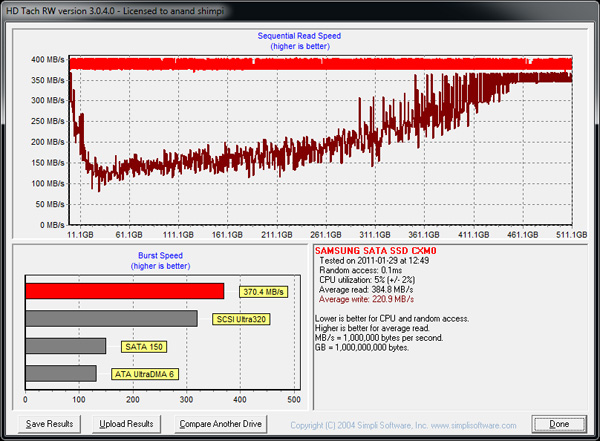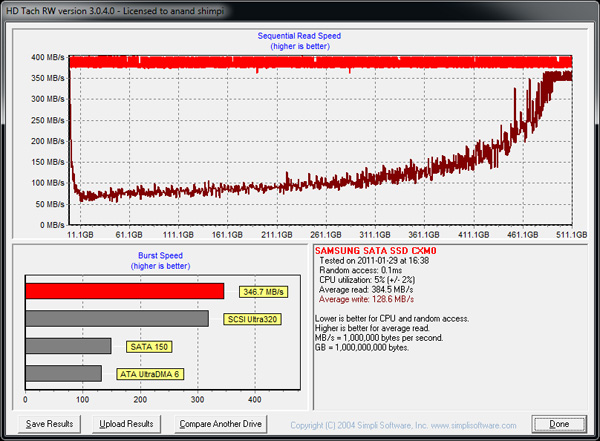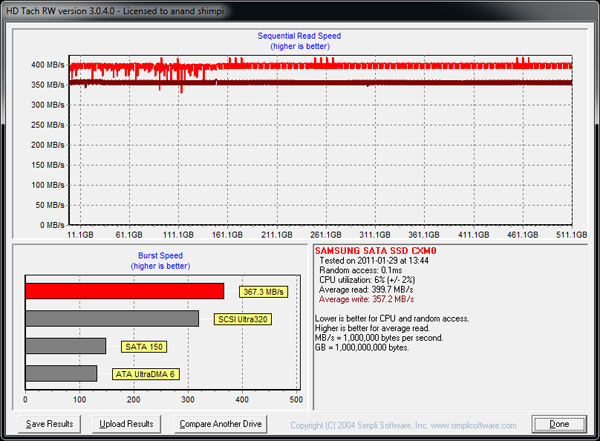The Samsung SSD 830 Review
by Anand Lal Shimpi on September 24, 2011 1:02 AM EST- Posted in
- SSDs
- Storage
- Samsung
- pm830
- Samsung SSD 830
Performance Over Time & TRIM
My biggest issue with Samsung SSDs in the past has been their extremely poor performance over time. Samsung doesn't do a lot of active garbage collection while writing in order to maintain ultra high write speeds, instead it prefers to clean up the drive during periods of little to no IO activity. Unfortunately this approach can result in pretty poor performance over time. In the old days the Samsung controllers would hit single digit write speeds, often slowing down to sub-HDD speeds. These days things are a lot better but it's still a concern. To quantify the behavior I filled all user addressible LBAs on the SSD 830, then proceeded to run our random write torture test on the now-dirty drive. After 20 minutes of torture I ran a single sequential read/write pass to measure how much of a hit the drive took.
Sequential read/write performance should be around 400/330 according to Iometer. Here's what the drive looks like after our torture test:
There's a significant drop in performance but the drive is still able to deliver ~100MB/s speeds. This graph is a bit deceptive however. After 20 minutes of 4KB random writes the SSD 830 will only write at a rate of around 20MB/s. By not doing much realtime garbage collection the random write speed can drop significantly over time, but at a lower write speed the 830 isn't penalized as much as other drives. To help deal with this issue I extended the length of our torture test to 60 minutes and re-ran:
Ah that's a lot more like it. Performance drops significantly, down to as low as 50MB/s for the earliest LBAs. Given enough idle time the 830 should correct much of this and obviously TRIMing those LBAs will restore full performance (as you'll see below) but the point is that by delaying the bulk of garbage collection the Samsung SSD 830 is able to drop in performance by a degree that I'm not super comfortable with. This phenomenon isn't exclusive to Samsung, you'll remember that we've complained about it with Crucial drives as well. Other than SandForce and Intel most controller manufacturers tend to follow a similar clean up the mess later approach to firmware design. In my opinion I'd much rather see lower peak performance and get higher worst case scenario performance as it tends to impact the user experience less.
If you are running under a TRIM enabled OS performance does restore to peak quite nicely after a TRIM pass:













99 Comments
View All Comments
Herp Derpson - Saturday, September 24, 2011 - link
Anand, it would be very interesting to read about hardware AES encryption in SSDs - how do you use it and how does it affects performance.juhatus - Saturday, September 24, 2011 - link
Yeap, I heard that AES basicly kills all-compressing Sandforce's?Maybe test with win7's bitlocker?
Ryan Smith - Saturday, September 24, 2011 - link
Only if you leave encryption up to the OS. With a SF SSD you should be leaving it up to the drive - AES encryption is basically free on those drives, they just run the cypher after dedupe and compression.zanon - Saturday, September 24, 2011 - link
There are plenty of valid reasons though not to leave encryption up to the drive, ranging from a need for other features/management (like multiple factors) to just plain not trusting encryption where no source review or updates are available. Perhaps most importantly is the simple observation that it's probable that the vast majority of FDE users are using either software (Truecrypt/PGP or whatever) or OS level solutions.Given that, I think it's a valid situation to consider, along with filesystem-level compression.
docbones - Monday, October 10, 2011 - link
I would love to see a benchmark article on whole disk encryption across drive types. (especially interested in how does the seagate hybrids do)iwodo - Saturday, September 24, 2011 - link
was it tested with new firmware?Anand Lal Shimpi - Saturday, September 24, 2011 - link
The initial graphs used the older fw but after realizing the mistake I updated the numbers to the latest FW0009 numbers, so yes :)Take care,
Anand
Beenthere - Saturday, September 24, 2011 - link
I'd be interested in a number of SSDs if they ever sort out the reliability and compatibility issues. I had hoped by now this would have happened but clearly it has not. This is like OJT for SSD makers I guess.soliozuz - Saturday, September 24, 2011 - link
It's funny you mentioned that because I think you just jinxed both companies. it seems that Apple will no longer be relying on Samsung for it's Nand Flash and etc. Now the reasons as to why they would dump someone as reliable as Samsung is beyond me.Source: http://www.techspot.com/news/45591-apple-decreasin...
In regards to the SSD, I must admit, as great of a thing they have done with this drive, I kind of was left expecting more. Samsung made a statement last year releasing a SATA II SSD especially with the kind of power consumption they had on it. I think that's key for future products.
jwilliams4200 - Saturday, September 24, 2011 - link
If you read the source article (Digitimes), it is stated that Apple is apparently diversifying its suppliers from Samsung because of patent disputes with Samsung.